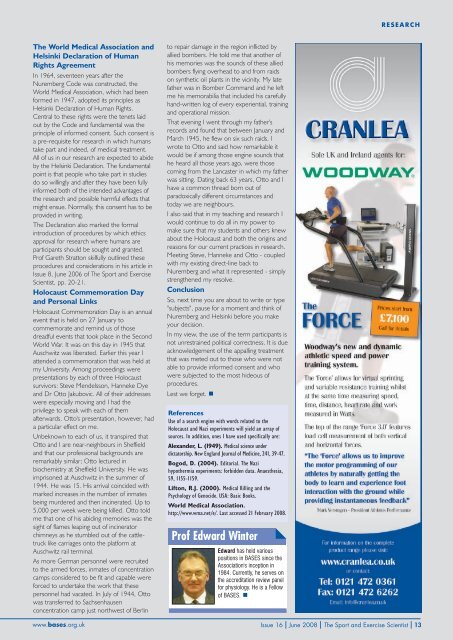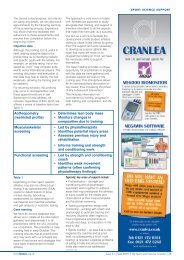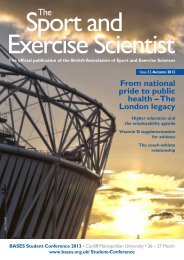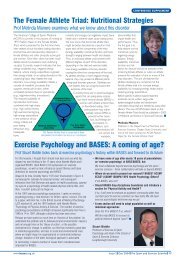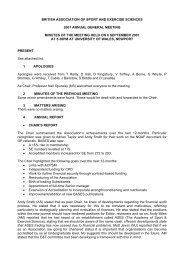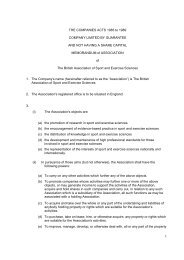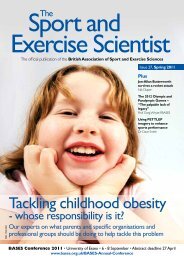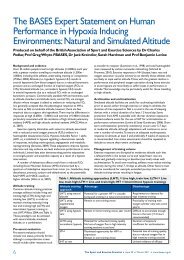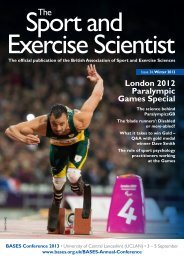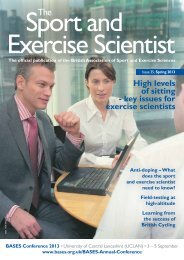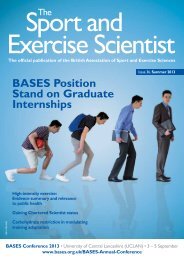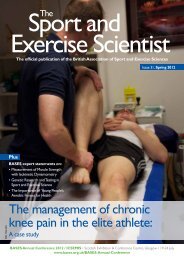COURTESY OF THE UNITED STATES HOLOCAUST MEMORIAL MUSEUM.COURTESY OF KEYSTONE - FRANCE, CAMERA PRESS LONDON.RESEARCHExperiments: why "participants" rather than "subjects"?Prof Edward Winter provides a persuasive account on why researchers should encourage participation and not subjugationRecently, I have had exchanges withcolleagues both here in the UK andoverseas along with editors of journals - andindeed contributors - about the use of theterm "participants" as a preferred descriptorof those who take part in experiments overthe traditional "subjects".Some of the correspondents have beenadvocates while others have beendetractors. Objections to the use ofparticipants fall broadly into one of twocategories: first, on the grounds that it isout-of-control political correctness orsecond, that subjects is the term that hasalways been used so why change?The Nuremberg MilitaryTribunalsThe background to why participants ispreferred has to be understood and thisbackground is both sombre and profound.It is also becoming shrouded in the mists oftime and many are either unaware orunclear about the historical context (Bogod,2004). At the end of the Second WorldWar, the Nuremberg Military Tribunals wereheld to try senior members of the Germangovernment and military who had initiated,perpetrated and supported the mostappalling of crimes against humanity. Thesetrials took place in Nuremberg's Palace ofJustice from 1945-1949. The first trial wasof military personnel.Twenty four defendants were arraigned. Ofthese 24, 12 were sentenced to death andhanged in 1946 although one, head-of-the-Luftwaffe (German air force), HermanGöring committed suicide before sentencecould be carried out and another, MartinBorman was tried and convicted in hisabsence. Seven were imprisoned for termsthat ranged from 10 years to life, threewere acquitted, one committed suicidebefore trial and one was considered to beunfit for trial.Defendants in the dock at theDoctors' Trial 1946 - 1947The Doctors' Trial andNuremberg CodeThere were several other trials that fellunder the aegis of the tribunals but one inparticular stands out: the Doctors' Trial.Strictly speaking, this trial was entitledUnited States of America v. Karl Brandt etal. after the lead doctor, Karl Brandt, whowas among other things, Hitler's personalphysician. Brandt was held responsible forcrimes that included medical experimentsthat were forced on humans. Thedefendants in the trial were medicalpersonnel and their associates and thoseaccused are shown in the photo below.Brandt is on the front row, bottom left.Of the 23 defendants, 20 were medicallyqualified. All were accused of having beeninvolved in some form of Nazi humanexperimentation. Most of the charges werein connection with attempts to devisemeans of mass extermination of groupingssuch as Jews, gypsies, homosexuals andthose considered to be either mentallyunstable or infirm.At the time of trial, there were no definedprinciples for ethical conduct in studies. As aresult psychiatrist and neurologist Dr LeoAlexander was appointed to provideguidance. He submitted to the Counsel forWar Crimes a list of six points that definedlegitimate medical research. The trialinvestigators adopted these points and addedfour more. These 10 points became knownas the Nuremberg Code and it was againstthis Code that judgement was made and thatthe defendants had flagrantly violated.Later, the Code formed the basis of theUnited Nations Universal Declaration ofHuman Rights that was adopted on 10December 1948 at the Palais de Chaillot,Paris. Later still, this declaration wasadopted in 1964 by the World MedicalAssociation that is known as the HelsinkiHuman Rights Agreement. Although theorigins are in 1948, it is this Agreement thattends to be the one that is recognised andguides our research.Among experiments conducted bydefendants were those sponsored by theLuftwaffe. They became known as thefreezing experiments and were designed toimprove methods of rewarming and hence,increase the chances of survival both ofGerman aircrew who were shot downover open water and other members of theGerman army who were fighting inexceptionally cold conditions. These horrificexperiments were conducted betweenAugust and October 1942 at Dachau andelsewhere at Auschwitz and Birkenauconcentration camps under the supervisionof Dr Sigmund Rascher. The photo belowshows Holzlöhner on the left and Rascherpresiding over such an experiment in whicha victim, dressed in Luftwaffe uniform, isimmersed in an ice bath. Some 360 - 400inmates were subjected to these and similarprocedures and 80 - 90 died.The freezing experimentsThese deaths were deliberate and adescription of the time-course of fatalitieswas reported by Rascher's supervisor, DrAugust Finke - a Professor at the Universityof Keil - to a medical conference inNuremberg on 10 October 1942. The titleof Finke's presentation was entitled,"Freezing experiments with Human Beings".Victims had no choice other than to takepart and had to do so without anaesthesia.They were subjected and subjugated in themost appalling of ways.Other experiments were also undertakensuch as those on the effects ofdecompression experienced at high altitude,infection and treatment of typhus,techniques for mass sterilisation,transplantation of limbs, making seawaterdrinkable and on heredity with homo- andhetero-zygous twins. The list is long. Aswith the freezing experiments, many deathsoccurred and these were intentional.Of the 23 doctors who were accused,seven were sentenced to death, five to lifeterms and four to terms of between 10 to20 years. Seven were acquitted.12 l Issue 16 l June 2008 l The Sport and Exercise Scientistwww.bases.org.uk
RESEARCHThe World Medical Association andHelsinki Declaration of HumanRights AgreementIn 1964, seventeen years after theNuremberg Code was constructed, theWorld Medical Association, which had beenformed in 1947, adopted its principles asHelsinki Declaration of Human Rights.Central to these rights were the tenets laidout by the Code and fundamental was theprinciple of informed consent. Such consent isa pre-requisite for research in which humanstake part and indeed, of medical treatment.All of us in our research are expected to abideby the Helsinki Declaration. The fundamentalpoint is that people who take part in studiesdo so willingly and after they have been fullyinformed both of the intended advantages ofthe research and possible harmful effects thatmight ensue. Normally, this consent has to beprovided in writing.The Declaration also marked the formalintroduction of procedures by which ethicsapproval for research where humans areparticipants should be sought and granted.Prof Gareth Stratton skilfully outlined theseprocedures and considerations in his article inIssue 8, June 2006 of The Sport and ExerciseScientist, pp. 20-21.Holocaust Commemoration Dayand Personal LinksHolocaust Commemoration Day is an annualevent that is held on 27 January tocommemorate and remind us of thosedreadful events that took place in the SecondWorld War. It was on this day in 1945 thatAuschwitz was liberated. Earlier this year Iattended a commemoration that was held atmy University. Among proceedings werepresentations by each of three Holocaustsurvivors: Steve Mendelsson, Hanneke Dyeand Dr Otto Jakubovic. All of their addresseswere especially moving and I had theprivilege to speak with each of themafterwards. Otto's presentation, however, hada particular effect on me.Unbeknown to each of us, it transpired thatOtto and I are near-neighbours in Sheffieldand that our professional backgrounds areremarkably similar; Otto lectured inbiochemistry at Sheffield University. He wasimprisoned at Auschwitz in the summer of1944. He was 15. His arrival coincided withmarked increases in the number of inmatesbeing murdered and then incinerated. Up to5,000 per week were being killed. Otto toldme that one of his abiding memories was thesight of flames leaping out of incineratorchimneys as he stumbled out of the cattletrucklike carriages onto the platform atAuschwitz rail terminal.As more German personnel were recruitedto the armed forces, inmates of concentrationcamps considered to be fit and capable wereforced to undertake the work that thesepersonnel had vacated. In July of 1944, Ottowas transferred to Sachsenhausenconcentration camp just northwest of Berlinwww.bases.org.ukto repair damage in the region inflicted byallied bombers. He told me that another ofhis memories was the sounds of these alliedbombers flying overhead to and from raidson synthetic oil plants in the vicinity. My latefather was in Bomber Command and he leftme his memorabilia that included his carefullyhand-written log of every experiential, trainingand operational mission.That evening I went through my father'srecords and found that between January andMarch 1945, he flew on six such raids. Iwrote to Otto and said how remarkable itwould be if among those engine sounds thathe heard all those years ago, were thosecoming from the Lancaster in which my fatherwas sitting. Dating back 63 years, Otto and Ihave a common thread born out ofparadoxically different circumstances andtoday we are neighbours.I also said that in my teaching and research Iwould continue to do all in my power tomake sure that my students and others knewabout the Holocaust and both the origins andreasons for our current practices in research.Meeting Steve, Hanneke and Otto - coupledwith my existing direct-line back toNuremberg and what it represented - simplystrengthened my resolve.ConclusionSo, next time you are about to write or type"subjects", pause for a moment and think ofNuremberg and Helsinki before you makeyour decision.In my view, the use of the term participants isnot unrestrained political correctness. It is dueacknowledgement of the appalling treatmentthat was meted out to those who were notable to provide informed consent and whowere subjected to the most hideous ofprocedures.Lest we forget. ReferencesUse of a search engine with words related to theHolocaust and Nazi experiments will yield an array ofsources. In addition, ones I have used specifically are:Alexander, L. (1949). Medical science underdictatorship. New England Journal of Medicine, 241, 39-47.Bogod, D. (2004). Editorial. The Nazihypothermia experiments: forbidden data. Anaesthesia,59, 1155-1159.Lifton, R.J. (2000). Medical Killing and thePsychology of Genocide. USA: Basic Books.World Medical Association.http://www.wma.net/e/. Last accessed 21 February 2008.Prof Edward WinterEdward has held variouspositions in BASES since theAssociation's inception in1984. Currently, he serves onthe accreditation review panelfor physiology. He is a Fellowof BASES. Issue 16 l June 2008 l The Sport and Exercise Scientist l 13


